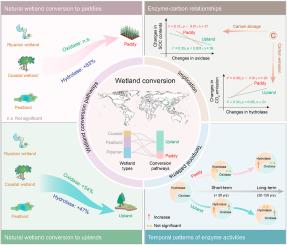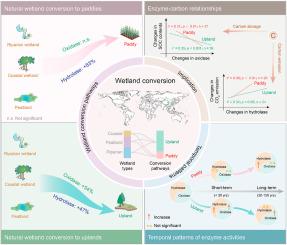水解酶-氧化酶反应介导不同的碳动态后,湿地转化为水稻与旱地系统
IF 10.3
1区 农林科学
Q1 SOIL SCIENCE
引用次数: 0
摘要
将天然湿地广泛转化为农业系统威胁到它们的碳储存能力。预测转化后土壤有机碳(SOC)动态仍然具有挑战性,主要是由于在转化途径中缺乏表征的SOC分解模式。考虑到水解酶针对的是不稳定的聚合物,而氧化酶降解的是不稳定的聚合物,它们的不同反应可能解释了湿地转化后不同的有机碳动态。通过一项全球荟萃分析(来自113项研究的424项观察结果),我们评估了水稻或高地转化后的酶反应。我们发现了三个关键模式:(i)转化为稻田使水解酶活性提高了83% (95% ci: 50-123%),同时保持了稳定的氧化酶水平(p > 0.05),而转化为高地则使水解酶[47%(27-71%)]和氧化酶[54%(27-88%)]活性都提高了;转化前湿地的生物地球化学特性(如沿海盐度、泥炭地酸度)调节了转化为高地而非稻田后的酶反应;(iii)向高地转化的水解酶活性在早期(0-30年)迅速增加,随后达到稳定状态。相比之下,水稻转化初期水解酶没有明显变化,仅在后期(30-150年)才出现显著积累。氧化酶活性随着时间的推移在高地逐渐增加,但在稻田保持稳定。关键是,氧化酶反应与有机碳含量呈负相关,而水解酶反应与二氧化碳排放通量呈正相关。这些关系表明,尽管增加了二氧化碳排放,但向稻田的转化可以保持有机碳储量,而向高地的转化可能导致大量的有机碳损失,而温室气体排放相对较低。我们的研究结果证实了转化途径中不同的酶反应,为解释转化后农业系统中有机碳动态提供了基于酶的见解。本文章由计算机程序翻译,如有差异,请以英文原文为准。


Hydrolase-oxidase responses mediate distinct carbon dynamics following wetland conversion to paddy versus upland systems
Extensive conversion of natural wetlands to agricultural systems threatens their carbon storage capacity. Predicting post-conversion soil organic carbon (SOC) dynamics remains challenging, largely due to poorly characterized SOC decomposition patterns across conversion pathways. Given that hydrolases target labile polymers and oxidases degrade recalcitrant polymers, their differential responses may explain divergent SOC dynamics following wetland conversion. Through a global meta-analysis (424 observations from 113 studies), we assessed enzymatic responses following conversion to paddies or uplands. We found three key patterns: (i) Conversion to paddies increased hydrolase activities by 83 % (95 % CIs: 50–123 %) while maintaining stable oxidase levels (p > 0.05), whereas conversion to uplands elevated both hydrolase [47 % (27–71 %)] and oxidase [54 % (27–88 %)] activities; (ii) Pre-conversion wetland biogeochemical properties (e.g., coastal salinity, peatland acidity) modulated enzymatic responses following conversion to uplands but not to paddies; and (iii) Conversion to uplands exhibited a rapid early-stage (0–30 years) increase in hydrolase activities, which subsequently reached a steady state. In contrast, conversion to paddies showed no discernible change in hydrolases initially, with a significant accumulation occurring only in the later period (30–150 years). Oxidase activities demonstrated a progressive increase in uplands over time but remained stable in paddies across all time periods. Critically, oxidase response negatively correlated with SOC contents, while hydrolase responses were positively linked to CO2 emission fluxes. These relationships suggested that conversion to paddies may preserve SOC stocks despite increasing CO2 emissions, while conversion to uplands may result in substantial SOC loss with relatively low greenhouse gas emissions. Our findings confirmed differential enzymatic responses across conversion pathways, providing enzyme-based insights for explaining post-conversion SOC dynamics in converted agricultural systems.
求助全文
通过发布文献求助,成功后即可免费获取论文全文。
去求助
来源期刊

Soil Biology & Biochemistry
农林科学-土壤科学
CiteScore
16.90
自引率
9.30%
发文量
312
审稿时长
49 days
期刊介绍:
Soil Biology & Biochemistry publishes original research articles of international significance focusing on biological processes in soil and their applications to soil and environmental quality. Major topics include the ecology and biochemical processes of soil organisms, their effects on the environment, and interactions with plants. The journal also welcomes state-of-the-art reviews and discussions on contemporary research in soil biology and biochemistry.
 求助内容:
求助内容: 应助结果提醒方式:
应助结果提醒方式:


